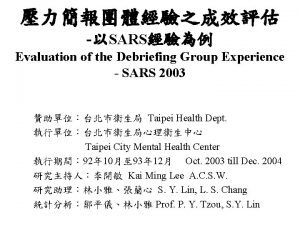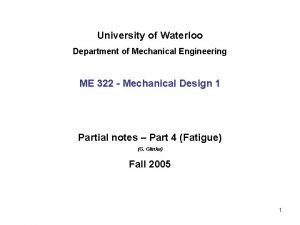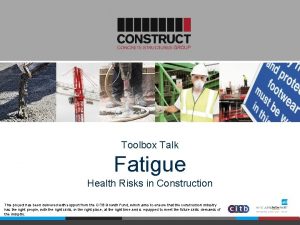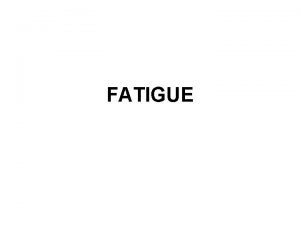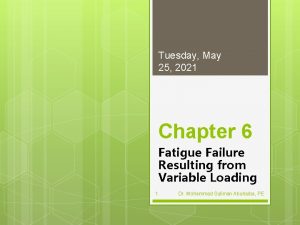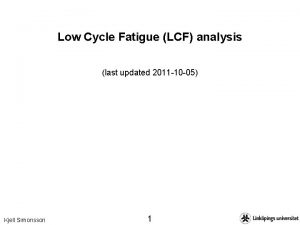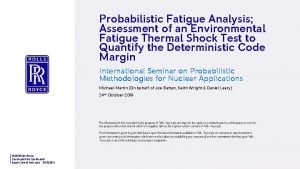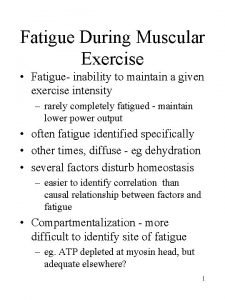High Cycle Fatigue HCF analysis cont last updated














- Slides: 14

High Cycle Fatigue (HCF) analysis; cont. (last updated 2011 -09 -28) Kjell Simonsson 1

The Haigh-diagram; cont. Reduction of the The Haigh-diagram It was previously shown how the Haigh diagram describes the mean stress effect under HCF conditions, where the values σfl and σflp are generally recorded for uniaxial-, bending- and torsional loadings. However, in order to use it in engineering applications, it needs to be modified with respect to life -reducing factors (not present in the laboratory environment/setup). The total reduction factor is given by 160 140 120 where all factors are (in the example to the left we have used a total correction factor of 0. 8) 100 80 60 40 20 0 0 Kjell Simonsson 100 200 300 400 2 500

The Haigh-diagram; cont. Reduction of the The Haigh-diagram; cont. Fatigue crack initiation generally takes place at, or near, the surface of a component. Thus, the surface conditions will affect the fatigue life • κ takes into account the surface smoothness (rough surface => shorter life) It may be noted, that if materials with a fatigue/endurance limit are subjected to extremely many cycles, they may still break, i. e. the SN-curve may drop below the fatigue/endurance limit after extremely many cycles. In this case the crack initiation may start anywhere in the specimen Kjell Simonsson 3

The Haigh-diagram; cont. Reduction of the The Haigh-diagram; cont. Metal working operations like drawing, rolling, forging etc affect the material in that it creates a plastically deformed state in the material and associated residual stresses. Thus, the prior deformation history of the specimen/component will affect the fatigue life • λ takes into account the technological volume dependency, i. e. the fact that smaller/thinner rods/sheets/shafts/… generally have undergone more severe size reducing operations, which will improve the fatigue properties. In the last edition of the formula table from the Swedish Institute of Technology, it is stated that λ only have to be considered for cast materials. Kjell Simonsson 4

The Haigh-diagram; cont. Reduction of the The Haigh-diagram; cont. A larger material volume is more likely to contain more and worse life limiting flaws. Thus, such a geometrical volume dependency will affect the fatigue life. It can e. g. be seen in the difference in fatigue limit for tension and bending, where the higher value of the latter is due to the fact that only the outer surface (or part of it, depending on the type of bending test) is subjected to the highest stresses. • δ takes into account the fact that for cases with a stress gradient present (such as bending and torsion conditions) a larger specimen/component size will imply a larger volume of more stressed material. If a stress concentration is present, the value of δ is to be set to 1, since for that case only a small portion of the body/structure will “feel” the highest stresses. Kjell Simonsson 5

The Haigh-diagram; cont. Reduction of the The Haigh-diagram; cont. Diagrams for κ, λ and δ can be found in the literature. In the case that other life limiting factors are present or other life limiting processes are operating, reduction of the Haigh-diagram must also be done with respect to these. One such example is environmental effects. Kjell Simonsson 6

The Haigh-diagram; cont. The fatigue notch factor When establishing the working point in the Haigh-diagram, representing the prevailing operating conditions, we must take into consideration that e. g. notches and other rapid geometry changes raise the local stress levels. However, it has been found that the amplitude stress (for fatigue life estimations) is not to be raised by the stress concentration factor Kt, but with a somewhat smaller value Kf, referred to as the fatigue notch factor. 160 140 where values for q, the so called notch sensitivity factor, can be found in the literature. 120 100 80 60 40 working point 20 0 0 Kjell Simonsson 100 200 300 400 7 500 To the left the total correction factor has been increased slightly, since δ must be set =1.

The Haigh-diagram; cont. Safety factor When establishing the safety factor against fatigue failure, one measures/calculates the relative distance to the reduced curve in the Haigh diagram. Depending on which quantity that is most uncertain, this may be done in three different ways. In the example to the left, the following safety factors S can be found 160 uncertain amplitude stress Sab=(a+b)/b=1. 9 140 120 100 80 a e d 60 uncertain mean stress Scd=(c+d)/d=3. 2 c f 40 b 20 equally uncertain stresses Sef=(e+f)/f=1. 7 working point 0 0 Kjell Simonsson 100 200 300 400 8 500

Linear damage accumulation Let us as an example consider the following load type of loading in a point Cycle 1 n 2 numbers of Cycle 2 1 sequence The question is now how to calculate the number of load sequences Ns to failure? The first simple approach is to say that the effects of the two loadings are independent of each other (often a questionable assumption), and that the following linear damage accumulation count by Palmgren & Miner can be adopted (also often questionable), where N 1 and N 2 are the number of cycles for each type of loading, and where N 1 f and N 2 f are the associated number of cycles to fatigue failure. Ns=N 1=N 2/n 2 Kjell Simonsson 9

Linear damage accumulation; cont. For a general case we define the damage D as with failure when D=1. The case of more general loadings and basic cycle count will be handled below! Kjell Simonsson 10

Cycle count For sequential, but irregular, loadings we must have ways to define the load cycles in the sequence. There are many ways to do this, and we will here briefly (by an example) present the widely used so called Rain Flow Count method. Having found the load cycles (where no information about the order is provided) we may then use the Palmgren-Miner approach described above. Now, consider the following load sequence, where we (due to the requirements from the RFC-method) have identified it by starting with the highest load value (could also have started with the lowest load value) Kjell Simonsson 11

Cycle count; cont. The Rain Flow Count method When adopting the Rain Flow Count method we flip the load curve to a vertical position, and then imagine that rain drops glide and fall on the so obtained roof-like structure. Since we are to split the load sequence into load cycles, no drop is to traverse a segment previously traversed by another drop. For the algorithm to work, we also must require that a drop stops when it reaches an equal or larger maximum or an equal or smaller minimum point. 3 4 5 1 7 2 8 6 1&6 2&5 3&4 7&8 Kjell Simonsson 12

Cycle count; cont. The Rain Flow Count method; cont. Another way to regain the result from the Rain Flow Count method, is to view the load sequence as a bath tub, where we in a sequential manner pull the deepest plugs. Kjell Simonsson 13

A final comment It is finally to be noted that fatigue, here discussed in the HCF context, is a difficult area, where a lot of empirical rules are used. These are not always commonly accepted, and specific rules and guidelines may e. g. be employed at different companies. Furthermore, small differences may also be found in how commonly accepted procedures are implemented/used. Kjell Simonsson 14
 Debriefing report
Debriefing report Cont or cont'd
Cont or cont'd During _______ branching, only car is updated with adr
During _______ branching, only car is updated with adr Rpms coaching and mentoring form
Rpms coaching and mentoring form Fatigue stress
Fatigue stress Compassion fatigue signs
Compassion fatigue signs Fatigue management toolbox talk
Fatigue management toolbox talk Ofcfbrazil
Ofcfbrazil Fatigue assessment tool
Fatigue assessment tool Fibromyalgia
Fibromyalgia Fatigue failure beach marks
Fatigue failure beach marks What is predominant energy system
What is predominant energy system Ted talk compassion fatigue
Ted talk compassion fatigue Gerber equation fatigue
Gerber equation fatigue Steinberg fatigue
Steinberg fatigue
